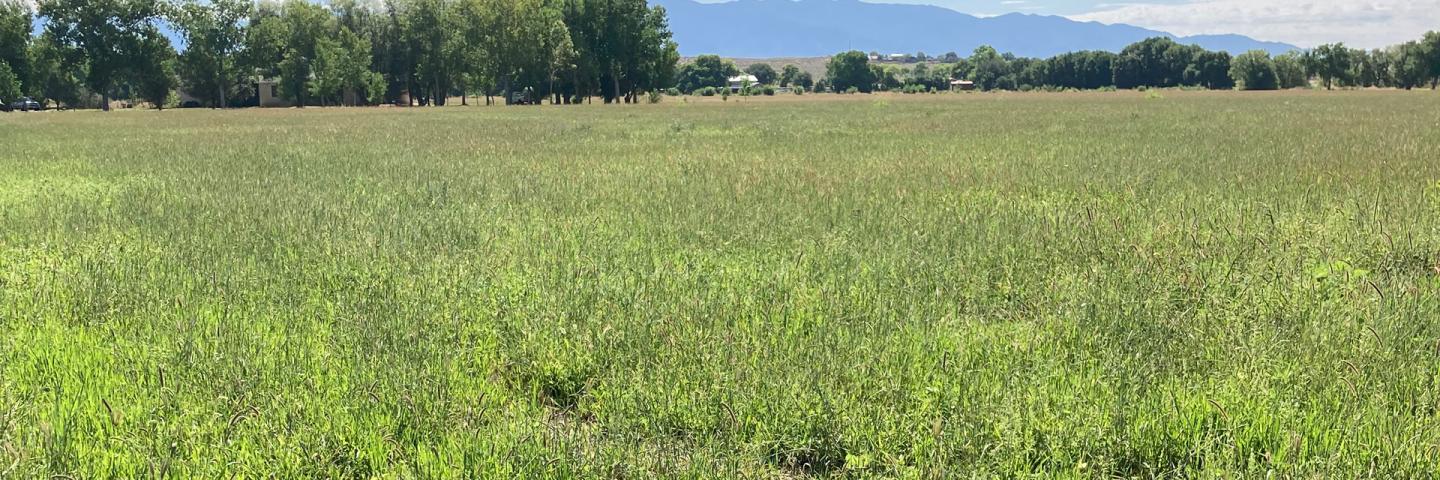
Agricultural Land Easements help private and tribal landowners, land trusts, and other entities such as state and local governments protect croplands and grasslands on working farms and ranches by limiting non-agricultural uses of the land through conservation easements.
The following are the ACEP application deadlines for fiscal year 2025:
October 4, 2024: 1st batching date for IRA funding
November 8, 2024: batching date for NM ACEP-ALE
December 20, 2024: 2nd batching date for IRA funding
What are the benefits?
ALE funding and the required conservation easement deed help farmers and ranchers keep their land in agriculture. Landowners maintain control over who can access the land and have peace of mind knowing the land will never be developed. Easements can make land more affordable for future farmers by removing development potential. Farmland, grasslands, wetlands and open space promote human health and happiness and provide environmental benefits such as groundwater recharge, wildlife habitat and clean air.
Who is eligible?
Applications are received from entities that have the authority to purchase and hold conservation easements and have an established agricultural land protection program. Entities include American Indian tribes, state and local governments and non-governmental organizations.
Eligible landowners include individuals, corporations, trusts and Indian tribes.
Please review the fact sheets below for more information on ALE entity and landowner eligibility requirements.
What land is eligible?
Land eligible for agricultural easements includes private or Tribal land that is cropland, rangeland, grassland, and pastureland. Shrubland is eligible if grazing is the predominant use. Forest land is eligible on no more than two-thirds of the easement area and must contribute to the economic viability of the agricultural operation or serve as a buffer to protect the easement land from development.
Please review the fact sheets below for more information on land requirements.
Ranking Information
Eligible parcels are selected based on a ranking process that includes an assessment of the ecological condition of the land. The ranking process is how NRCS determines the conservation value and cost-effectiveness of the proposed action on the selected land units. If adequate funds are not available to fund the next highest ranked parcel, the State may select the next highest ranked parcel for which sufficient funding is available.
Applications for grasslands of special significance (GSS) are ranked in a separate ranking pool from other ALE applications. Applications are ranked using the Conservation Assessment Ranking Tool (CART).
Click here to learn how to sign up for free email and text alerts about the latest NRCS program and national funding opportunities.
New Mexico Contacts
Kenneth Branch
Assistant State Conservationist for Programs
(505) 761-4454
E-mail: kenneth.branch@usda.gov
Athena Cholas
Resource Conservationist
(505) 761-4419
E-mail: athena.cholas@usda.gov
Ready to get started?
Contact your local service center to start your application.
How to Get Assistance
Do you farm or ranch and want to make improvements to the land that you own or lease?
Natural Resources Conservation Service offers technical and financial assistance to help farmers, ranchers and forest landowners.

To get started with NRCS, we recommend you stop by your local NRCS field office. We’ll discuss your vision for your land.
NRCS provides landowners with free technical assistance, or advice, for their land. Common technical assistance includes: resource assessment, practice design and resource monitoring. Your conservation planner will help you determine if financial assistance is right for you.
We’ll walk you through the application process. To get started on applying for financial assistance, we’ll work with you:
- To fill out an AD 1026, which ensures a conservation plan is in place before lands with highly erodible soils are farmed. It also ensures that identified wetland areas are protected.
- To meet other eligibility certifications.
Once complete, we’ll work with you on the application, or CPA 1200.
Applications for most programs are accepted on a continuous basis, but they’re considered for funding in different ranking periods. Be sure to ask your local NRCS district conservationist about the deadline for the ranking period to ensure you turn in your application in time.
As part of the application process, we’ll check to see if you are eligible. To do this, you’ll need to bring:
- An official tax ID (Social Security number or an employer ID)
- A property deed or lease agreement to show you have control of the property; and
- A farm number.
If you don’t have a farm number, you can get one from USDA’s Farm Service Agency. Typically, the local FSA office is located in the same building as the local NRCS office. You only need a farm number if you’re interested in financial assistance.
NRCS will take a look at the applications and rank them according to local resource concerns, the amount of conservation benefits the work will provide and the needs of applicants. View Application Ranking Dates by State.
If you’re selected, you can choose whether to sign the contract for the work to be done.
Once you sign the contract, you’ll be provided standards and specifications for completing the practice or practices, and then you will have a specified amount of time to implement. Once the work is implemented and inspected, you’ll be paid the rate of compensation for the work if it meets NRCS standards and specifications.

